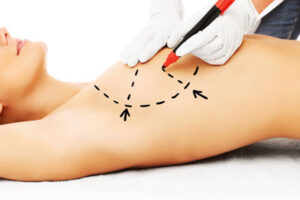Breast reduction surgery is performed to give the breasts a more aesthetic appearance and if any, to solve some medical and psychological health problems which may be caused by large breasts. Excessively large breasts may be due to hormonal causes, hereditary characteristics and overweight. The main health problems that may be experienced due to large breasts are:
• Back, neck and shoulder pain
• Rash and bad odour under the breasts
• Posture disorder (hunchback)
• Deep scars on the shoulders due to bra straps
• Restriction of daily activities and sports activities
• Obesity due to lack of exercise and restriction of movement
• Psychosocial problems, especially in young people
 Therefore, breast reduction surgery is in fact a surgery that provides both aesthetic and functional benefits to women.
Therefore, breast reduction surgery is in fact a surgery that provides both aesthetic and functional benefits to women.
During breast reduction surgery, excess breast fat tissue, mammary gland tissue and breast skin are removed and a breast of the planned dimensions is shaped in harmony with the body shape. With women who want to become pregnant and breastfeed in the future, breast reduction surgery is planned in accordance with these future expectations in mind.
What is breast reduction surgery?
The surgery performed to shape a breast in a size compatible with the body by removing excess fat tissue, mammary gland tissue and breast skin and to eliminate health issues related to excessively large breasts is called ‘Breast Reduction Surgery’.
Why is breast reduction surgery performed?
Breast reduction surgery is performed to provide aesthetic and functional benefits to increase the quality of life for women who are aesthetically dissatisfied with their large breasts and who experience psychosocial and medical problems.
What is the best age for breast reduction surgery?
Breast reduction surgery can be performed over the age of 18.
Am I a good candidate for breast reduction surgery?
• If your large breasts bother you aesthetically
• If your breasts physically restrict your daily activities and sports life
• If your breasts cause you back, neck and shoulder pain
• If deep scars remain on your shoulders due to bra straps
• If there are rashes and bad odour under your breasts
• If large breasts cause posture disorder
• If you are physically healthy
• If you are over the age of 18, you can have breast reduction surgery.
What should I do before breast reduction surgery?
 You should inform your physician about any chronic conditions you have like diabetes, cardiovascular or blood diseases. Any chronic disease should be under medical control such as your blood sugar level if you have diabetes. Your physician also needs to know if you have pregnancy plans after surgery. You should also share with your physician information about your breasts such as the things you do not like, size, asymmetry, width of the nipples, the bra size you want to wear when the breasts are reduced.
You should inform your physician about any chronic conditions you have like diabetes, cardiovascular or blood diseases. Any chronic disease should be under medical control such as your blood sugar level if you have diabetes. Your physician also needs to know if you have pregnancy plans after surgery. You should also share with your physician information about your breasts such as the things you do not like, size, asymmetry, width of the nipples, the bra size you want to wear when the breasts are reduced.
It is recommended thay you do not take aspirin, vitamin E, fish oil or similar blood thinners, birth control pills for 10 days before surgery. You should stop smoking at least 2 weeks before the operation. Alcohol intake is not advised during the 48 hours before surgery. When you come to the operation, you should be fasting for 8 hours. Just before the surgery, drawings of the planned breast shape are made while standing.
Step by step operation process:
Anaesthesia: General anaesthesia
Surgical Procedure: The procedures applied in all of the various methods are the same:
The planned amount of breast tissue is removed and repositioned.
The nipple is raised to a higher, normal position; if the nipple is large, its size is reduced.
If there is asymmetry between the breasts, it is corrected as much as possible.
What should I expect after breast reduction surgery?
 Eating is allowed from the 4th hour after the operation. You can stand up and start walking after eating.
Eating is allowed from the 4th hour after the operation. You can stand up and start walking after eating.
Vacuum drains are removed 3 to 5 days after the operation, and the tape covering the breast is removed within a week. Only thin tapes covering the suture lines remain.
The suture lines may become red, swollen and itchy during wound healing.
In addition, bruises that may occur in the operation area are temporary and disappear in a period of time depending on the skin characteristics. Pain is easily treated with ice application and painkillers.
What should I pay attention to after breast reduction surgery?
Smoking should be avoided for one month after the operation. The recommended compression bra should be worn day and night for one month. In this way, both pain relief is provided and the bra support will help to shape the reconstructed breast tissue.
How much rest is required after breast reduction surgery?
Rest at home is recommended for 3 to 7 days.
When can I return to work after breast reduction surgery?
You can start working after one week.
How long after breast reduction surgery can I start sports?
Light exercises can be started after one month, heavy sports can be done after 2 months.
What is the recovery time after breast reduction surgery?
The recovery period is one month, and it takes 6-12 months for the breast to take its final shape.
What results should I expect after breast reduction?
After the surgery, all the removed breast tissue is sent for pathological examination. The results of breast reduction surgery are immediately visible. Over time, the swelling regresses. After 2 months, the suture scars fade rapidly and become unnoticeable within 6 months to a year, but the scars are permanent. The final results appear in a few months as the breast shape and position continue to settle. Although the results of the surgery are long-lasting, the shape of your breasts may continue to change due to aging and gravity.
Frequently Asked Questions
Hormonal causes, hereditary characteristics and overweight cause breast enlargement.
Breastfeeding and weight loss can cause breasts to shrink in size.
If the appearance large breast aesthetically bothers you,
If you have back, neck and shoulder pain,
If you have rash and bad odour under your breasts,
If you have posture disorder (hunchback),
If deep scars are formed on your shoulders due to bra straps,
If you have to restrict your daily activities and sports activities due to large breasts,
If you have obesity due to lack of exercise and restriction of movement.
If there are psychosocial problems, then breast reduction surgery is necessary.
When considereing the appropriate age to have breast reduction, the most important issue is the completion of breast development. Therefore, it is generally recommended to be over the age of 18 for breast reduction surgery.
As long as the health of the person allows, every woman over the age of 18 can have breast reduction surgery.
For overweight people, it is recommended to lose weight first. With breast reduction surgery, the desired aesthetic appearance of the breast can be achieved.
Breast reduction is planned in accordance with your expectations and body structure.
In order to have the desired breast size after surgery, planning is made in consultation with your physician beforehand.
Aspirin or similar blood thinners should be taken for 10 days before surgery, smoking should be avoided for 2 weeks before surgery, alcohol should not be consumed for 48 hours before surgery, and diabetes should be under medical control. Food and fluid intake should be stopped 8 hours before the operation.
It takes 2-3 hours depending on the technique to be applied.
Since breast reduction surgery treats many psychosocial and medical problems related to large breasts, it is both a cosmetic and functional surgery.
The planned amount of breast tissue is removed and repositioned.
The nipple is brought up to a higher, normal position; if the nipple is large, its size is reduced.
If there is asymmetry between the breasts, it is corrected as much as possible
Excess fat tissue, mammary gland tissue and breast skin are removed during breast reduction.
After breast reduction surgery, you might have mild pain. Pain is easily treated with ice application and painkillers.
After breast reduction surgery, there is no severe pain. Mild pain is relieved by ice application and painkillers.
After breast reduction surgery, there is no severe pain. The pain felt for a few days responds well to ice application and painkillers.
There may be swelling in the first few days after surgery. Swelling decreases within a few weeks.
It is recommended to wear a compression bra for 6 weeks after breast reduction surgery.
Yes. It is recommended to wear the compression bra day and night for a month.
If the compression bra is not worn, oedema may form and there will be pain in the breast.
A compression bra is important both for easier care of the surgical site and for proper shaping of the breast during the healing period.
You can sleep without a compression bra 6 weeks after the operation.
It is recommended to lie on your back for an average of one week.
In order to lift heavy things, you have to wait for 2 months after breast reduction surgery.
Home rest is recommended for one week after the operation.
2 months after the operation, the suture scars fade rapidly. Within 6 months to a year, they become unnoticeable, but the scars are permanent.
Full recovery after surgery can take up to one year.
Yes, it is a safe operation. Infection and bleeding are rarely seen.
Infection and bleeding are rarely seen. Depending on the technique applied, nipple sensation may be adversely affected. The breast’s lactation potential may also be affected.
There may be flattening and hardening of the nipple due to temporary swelling after surgery. As the swelling subsides, the nipple becomes prominent again.
Depending on the technique applied, nipple sensation may be negatively affected.
If you tell your physician before the operation that you want to breastfeed afterwards, the operation will be planned accordingly and your ability to breastfeed will not be affected.
You can become pregnant one year after the operation.
Breast reduction surgery is recommended once you stop breastfeeding, and the targeted weight is reduced, because you may still be overweight while breastfeeding.
If you share with your physician that you have a pregnancy and breastfeeding plan in the following years before you have this surgery, the surgery will be planned with the appropriate technique. Thus, you can easily give birth and breastfeed after the surgery.
Although the results of the surgery are long-lasting, your breasts may continue to change due to ageing and gravity. Breasts that grow due to weight gain during pregnancy may become smaller than before when breastfeeding ends.
You can start swimming after 2 months.
If you are overweight, it is more preferable to have surgery after losing weight.
It is important to reach the ideal body mass index by losing as much weight as you can before the surgery in order to shape the breast in accordance with your body shape.
During breast reduction surgery, excess breast tissue and fat is removed, and the nipple is brought higher. Thus, the shape of the breast changes.
Yes. When shaping the breast, the planned amount of tissue is removed from the breast and repositioned. Then the nipple is brought to a higher, normal position; if the nipple is large, it is reduced. Thus, the breast is also lifted.
Bleeding and infection may occur in the early period.
Nipple sensation may sometimes be adversely affected.
If it is not told in advance that breastfeeding is planned, there may be a decrease in the potential of milk production.
Breast reduction surgery does not negatively affect the imaging quality of breast ultrasound and mammography.
Among all cosmetic surgeries, breast reduction is one of the surgeries with the highest patient satisfaction. If weight is gained and lost rapidly after surgery, if pregnancy and breastfeeding occurs, there may be changes in the breast shape and volume, and the breasts may sag.


Leave a Reply
You must be logged in to post a comment.